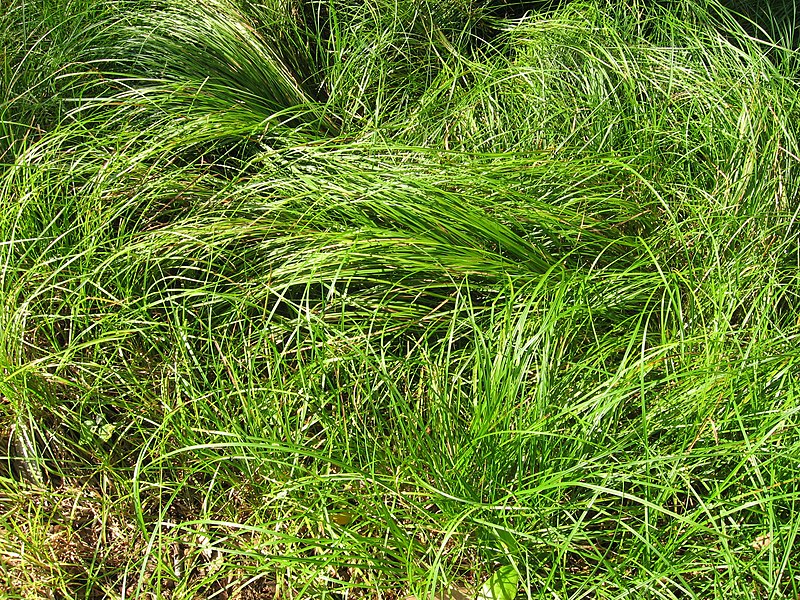 |
| New leaves on Vitex agnus-castus (chaste tree) are adorable! Chaste tree is native to the Mediterranean. It tends to leaf out a bit later than many of our native trees and shrubs, but the foliage is still susceptible to late frosts and freezes. (Our average last frost date is still two weeks away.) In 2014, temperatures dipped into the high 20s in mid-April, killing back all the newly emerged Vitex foliage. The damage turned out to be just temporary, with Vitex fully leafed out and looking fantastic a month later.) |
 |
| Beautiful new foliage on a native Viburnum dentatum (arrowwood viburnum) |
 |
| Teucrium chamaedrys 'Prostrata' (creeping germander) looking great. A couple of weeks ago I posted a photo (second to last in this post) showing how creeping germander stays semi-evergreen and attractive through the winter. It's fun to see how much it has leafed out and greened up since that previous post. |
 |
| Newly planted Ilex vomitoria, yaupon holly. According to BONAP, yaupon holly is barely native to Tennessee (there's a waif population in the extreme southwestern corner of the state, around Memphis), but it's certainly a regional native throughout the Deep South. I would have liked to start with a larger plant, but as usual, it's very hard to find natives at our local nurseries, so this is a 1-gallon mail order plant. I find myself charmed by the reddish new foliage and (I believe) flower buds. |
 |
| Physocarpus opulifolia, our native ninebark, I was so unimpressed with ninebark's performance last year that I almost shovel-pruned it over the winter. Still, learning from past mistakes (i.e. overly-hasty judgments), I decided to wait. So far, I'm very pleased with the new foliage on this plant. (For the life of me, I can't recall whether it's the 'Diablo' or 'Summer Wine' cultivar...) |
 |
| Salvia guaranitica, anise-scented sage or hummingbird sage. The new foliage looks better this year than it ever did in the past. (In fact, I was so unimpressed with its first-year performance in 2014 that I shovel-pruned it --- or tried to. It came back anyway in 2015 (typical zombie plant behavior) and I decided to give it a reprieve. Feeling quite good about that decision so far and hoping it will be bigger and better than ever this year. |
 |
| 'Queen of the Night' tulip from Easy to Grow bulbs. Whereas the earlier 'Pink Impression' tulips got chomped by some herbivore (let's blame the deer), so far these seem unmolested. 'Queen of the Night' is a really dark-flowered tulip. I had to use a flash to illustrate the interior of the bloom. I do think it's nice that there are early-flowering and late-flowering tulips so it's possible to spread out the tulip season over a month or more. (I'm guessing the deer might be less interested in late flowering tulips since there's probably more for them to eat in the woods this time of year now that many plants have leafed out.) |
 |
| Crabapple coming into bloom! This 'Sugar Tyme' crab has pink buds that open into white flowers. Charming :) |
 |
| Newly emergent foliage on threadleaf coreopsis Coreopsis verticillata (in this case the 'Zagreb' cultivar) looks like a miniature forest if you get down on the ground and look at it sideways. This is another plant that is a regional native (barely native to far southeastern Tennessee, but quite widespread in the Carolinas and Virginia. |
 |
| Here's a close-up on the newly emergent foliage on the evergreen Aucuba japonica. |
 |
| Love the fresh new foliage on this Agastache foeniculum, anise hyssop. Despite the fact that this plant is native to the far Northern plains, it seems to thrive in Middle Tennessee. Of course, it's no surprise that it survives the winter with flying colors and emerges early in the spring. What is surprising to me is that it seems cool as a cucumber during our hot, humid summers. Based on my experience, the Agastaches are a highly garden-worthy genus, especially if you like to attract pollinators who flock to their long-blooming purple summertime flowers. |
























